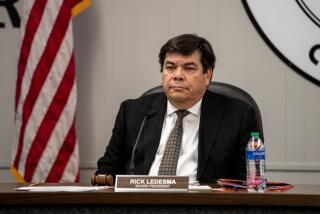Board Told to Return School Nurses and Scrap Test Program
- Share via
Health care and counseling provided by registered nurses in San Diego city schools, already inadequate because of staff shortages, was not improved by replacing a nurse with three less-qualified aides in an experimental project, a blue-ribbon panel has concluded.
The seven-member panel told the Board of Education on Tuesday to scrap the pilot program and return the registered nurse to the Mira Mesa and Scripps Ranch area.
“As the district would not have (teaching) aides serve as classroom teachers, so it should not employ less than fully credentialed nurses to lead the health service program at a school,” said Joan Gass, who headed the panel studying the six-month experiment.
“Indeed, a major finding of this study was that there were simply too few nurses in the pilot project to provide for the total health needs of the 11,000 students served,” she added.
The committee’s recommendation came just hours before the school board rejected a proposal to establish a clinic in a city high school to address health problems. The health clinic proposal was scuttled in part because the clinic might have distributed contraceptives to students.
School nurses are a more time-tested and less controversial method of providing health services and education to students. But last year, consultants hired by the board recommended that the district could save $894,000 by replacing some of its 112 registered nurses with licensed vocational nurses and health aides who have less training and would receive lower salaries.
The board voted to test the idea at Mira Mesa High School, Wangenheim Junior High School and the eight elementary schools that feed students to those secondary schools. The approximately 11,000 students at the 10 schools were served by five registered nurses and one nurse practitioner.
One of the five nurses was replaced by two part-time aides and one full-time aide qualified to handle minor first-aid cases and clerical duties. There was no cost savings under the experiment.
Instead of improved health services, the new staff configuration limited the time that school nurses--who attend a fifth year of college to become health educators--spent providing health information to students and staffers. Many nurses worked overtime to accomplish the state-mandated functions, such as vision and scoliosis screenings, that their replacements are not qualified to perform, the study showed.
Though the team of nurses performed some duties more efficiently, 85% of school staff members surveyed by the panel said that the pilot project decreased the time that nurses spent at their school. Fewer parents were contacted by nurses this year than last year. Nurses said the program had “a negative effect on the efficiency of the health care office as compared to last year.”
Only in the area of first aid was more service provided this year, the report showed. Gass speculated that that could be because the health aides were more thorough in documenting minor first-aid cases than nurses had been.
Overall, “the same level of funding did not provide the same level of care,” the report said.
Gass said she believes that the school system could make more use of aides--as assistants to the 112 registered nurses now on staff. The panel recommended that the school find ways to offer more nursing services, particularly at the 20% of city schools where children have access to a nurse only once a week.
The school system averages one nurse for every 1,800 students. In the high schools, the average is one nurse for every 2,239 students.
More to Read
Sign up for Essential California
The most important California stories and recommendations in your inbox every morning.
You may occasionally receive promotional content from the Los Angeles Times.










